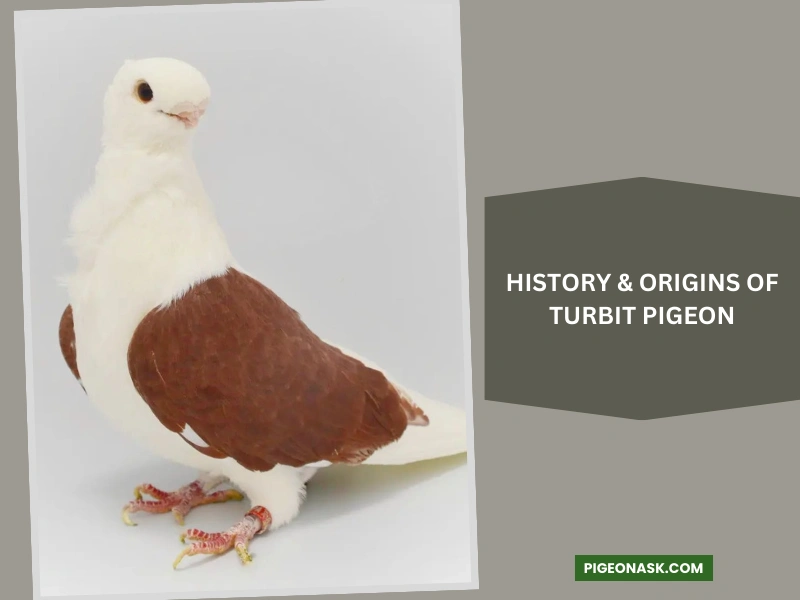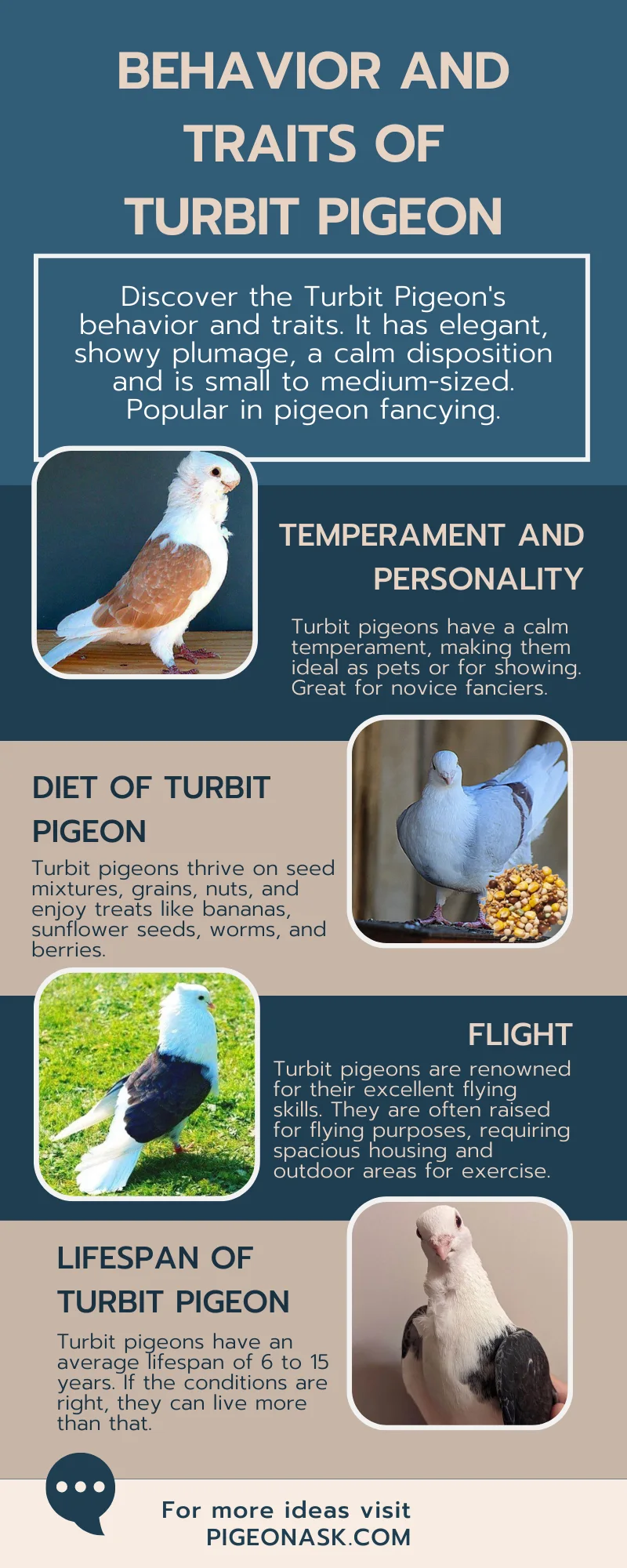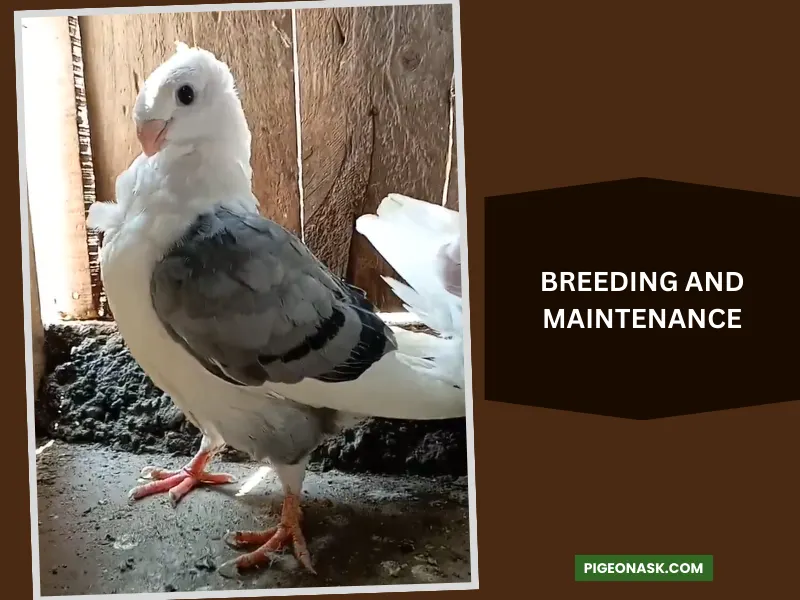Turbit Pigeon: History And Breed Guide
The Turbit pigeon is a breed of fancy birds and a descendant of the rock pigeon (Columbia Livia). It’s one of the easiest and hassle-free pigeons to raise, making them ideal for new and seasoned fanciers.
These birds are highly attractive due to their unique features and can do activities like flying or exhibition performances.
During this article, we will be talking about all things related to this beautiful pigeon, how to raise them correctly, and what to expect from the experience.
If you heard good things about Turbit, then be happy to know most of them are probably right! Learn all about it here!
Turbit Pigeon Profile
| Name | Turbit Pigeon |
|---|---|
| Scientific Name | Columbia livia |
| Origin | United Kingdom |
| Size | 28 – 32 cm |
| Weight | 225 grams – 290 grams |
| Lifespan | 6 – 15 years |
| Physical Features | Medium size, large head, broad neck, big eyes, white ceres, medium-sized red legs, colored wings |
| Temperament | Pleasant |
| Behavior | Calm and docile |
| Special Features | Short beak, peaked crest, frill feathers on the breast |
| Breeding and Maintenance | Easy |
| Common or Popular Varieties | Different colors |
Looking for more articles about pigeon breed:
Overview
The Turbit pigeon is a fancy bird. It has a medium-sized body, usually smaller than the average pigeon. This bird is also suitable for multiple purposes, including show and exhibition.
History and Origins of Turbit Pigeon
While the exact year of its development is not clear, the Turbit pigeon has been around since the XVII or XVIII century. In fact, popular ornithologists Francis Willughby and Moore already considered these pigeons a separate breed from owls in 1679 and 1735.

Interestingly enough, Rev. F.W. Lumley wrote the book “The Turbit Pigeon” back in 1894 and is one of the biggest references for this bird.
The general belief is that the Turbit pigeon as we know it originated in the United Kingdom.
This pigeon was the result of selective breeding, usually attributed to the crossbreeding of the Anatolian Owl and the Show Antwerp.
Physical Characteristics and Features
Some of you are new to the Turbit pigeon and probably not sure what the Turbit pigeon looks like. Well, they have a set of features that make it easy to identify this type of bird. Learn all about it here!
Appearance, Body Structure, Size, and Weight
Turbit pigeons are birds of medium size, featuring a tight and compressed body structure. They walk straight and show fancy traits like a white color on their body and one of multiple colors on the wings.
The size of this pigeon is equally interesting. It has a length between 28 and 32 cm, and the wingspan can be from 60 to 70 cm.

Similarly, the body frame is considerable, as the pigeon can weigh between 225 and 290 grams.
Due to these characteristics, the Turbit pigeon is usually smaller than most other pigeons. Plus, the body of this bird is dainty compared to its bigger head.
The head of the Turbit pigeon is broad, similar to the arched neck. Also, the eyes are large, and they mostly have white ceres. On the lower half, the pigeons have red legs of medium size.
Unique Features
Three distinct features differentiate the Turbit pigeon from other birds. For starters, they have short beaks and peaked crests. Another unique feature of these pigeons is the frill of feathers found below the neck.
Common Variation
Turbit pigeons are generally white, but they can also be other colors.
Typically, this pigeon can be black, blue, red, yellow, silver, and other less common colors like dun and cream. Experienced fanciers will aim for white-colored Turbit pigeons before the rest.
Behavior and Traits of Turbit Pigeon
The following section details crucial information that you should know about this pigeon.

Temperament and Personality
Turbit pigeons have a quiet temperament, which makes them pleasant birds. For this reason, this pigeon can be a docile pet, whether you keep it at home or use it for show purposes.
Anyone starting as a fancier would have a satisfying experience caring for these birds.
Diet
The diet of Turbit pigeons is similar to most other pigeons. For example, you must provide these birds with seed mixtures, cereals, and grains. They also love nuts, which can be good treats for them.
You may also want to reward them with bananas, sunflower seeds, popcorn, worms, and berries.
Flight
This breed of pigeons has outstanding flying ability. Furthermore, fanciers often raise these pigeons for flying purposes due to their remarkable flight.
Hence, this is another reason why the Turbit breed has spacious housing and access to outside areas to use their wings and enjoy flying.
Lifespan
Turbit pigeons have an average lifespan of six to fifteen years. If the conditions are right, they can live more than that.
Breeding and Maintenance
As I’ve mentioned earlier, the Turbit pigeon is a breed of selective crossbreeding.
So, choosing a pair with healhty traits like the right color, size, and temperament is necessary for the successful breeding of Turbit pigeons to ensure the next generation.

Fortunately, the Turbit pigeon does not require special care or attention. You can perform the usual tasks like cleaning the droppings and providing food and water, and that’s about it.
Additionally, you must take standard precautions, like keeping the birds away from predators and ensuring they have proper ventilation.
Some Tips and Considerations for Successful Breeding
- The Turbit pigeon is a very social animal. Therefore, you want to keep it in groups and avoid isolation.
- You can create ideal conditions for the pigeons to feel more comfortable. For example, you can include branches to let the Turbit pair fly around and feel relaxed.
- If you notice a sick pigeon, remove it from the rest of the group. Return it only when the bird heals completely.
- Choose the mating pair based on factors like color and size. These elements will be an indicator of what the offspring should look like.
- Lastly, you should consider using pigeon conditioner if you intend to use the pigeons for exhibition.
Feeding and Housing Requirements
Providing food for the Turbit pigeons is necessary every morning and by the end of the day. Constant water supply is equally crucial, which you can insert in the housing in a bowl or similar container.
If you notice the birds are not eating the amount of food, remove a considerable amount until they get just enough.
What About the Housing?
A loft is the most suitable place to keep your Turbit pigeons. Usually, these areas are spacious enough to let them walk around and flap their birds. Likewise, groups of Turbit birds can socialize, and branches could also be present so they can fly around.
Make sure the loft is clean, and scrape off any droppings, dirt, or food stuck on the floor. This action will avoid the potential spread of illnesses among the birds.
Final Word
The Turbit pigeon is an interesting bird with some unique characteristics. Additionally, they’re super fun to raise! This is why we recommend this breed of pigeons for beginner and experienced fanciers.
Besides being good-looking, Turbit pigeons can be great for multiple purposes, like shows, exhibitions, and even flying, not just as pets!
Like this article? Connect with our socials on Facebook, Twitter, and Pinterest to stay updated on all bird-related pieces and much more!
